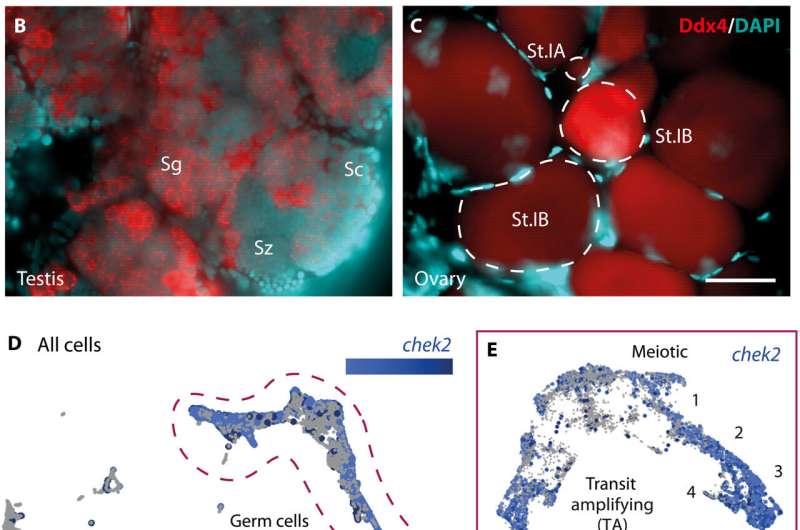This article has been reviewed according to Science X's editorial process and policies. Editors have highlighted the following attributes while ensuring the content's credibility:
fact-checked
peer-reviewed publication
trusted source
proofread
Immune cells drive sex reversal in zebrafish, a discovery that could improve treatments for female infertility

Mutations that disrupt development of germ cells cause infertility or birth defects. Mutations that cause female infertility in humans, such as mutations in the gene BMP15, also cause infertility in zebrafish. However, female zebrafish can undergo a complete reversal of sex traits.
Researchers at the Icahn School of Medicine and the University of California, Davis have studied how to prevent ovary cell loss, as well as the sex reversal in fish from ovary to testis. The experts explored which specific cells facilitate ovarian failure and sex reversal, and by identifying these cells, have determined potential pathways to prevent ovarian failure.
Their findings are published in the journal Science Advances.
In humans, as in zebrafish, sex organ formation begins with a genital ridge that is identical in males and females that later forms an ovary or testis. After sex determination, an ovary may experience premature ovarian failure as a result of fertility disorders or loss of cells and follicles that lead to masculinization. Masculinization is the development of male sexual characteristics in a female. In the case of female zebrafish, ovarian failure can result in complete female to male sex reversal.
The researchers discovered that ovarian immune cells called macrophages are the critical drivers of ovarian failure and masculinization, according to the study. Maintenance of ovarian follicles in animals require the gene BMP15. Similarly, in humans, BMP15 has been implicated in reproductive disorders that cause premature ovarian insufficiency or premature ovarian failure. These conditions not only lead to sterility, but more broadly affect female health including bone, cardiovascular, neurological, and autoimmune conditions like rheumatoid arthritis and lupus.
In this study, the experts used genetic approaches to screen for the cell types that are responsible for ovarian failure associated with mutations in the BMP15 gene. They found that the complete elimination of macrophages prevented ovarian cell loss and sex reversal. Further, they used single-cell RNA sequencing to identify the genes expressed by individual cells in the fishes' ovaries and identified a subset of cells that produce immune-regulating proteins.
"The cells and pathways that we identified represent potential therapeutic targets to preserve fertility and ameliorate reproductive disorders, including polycystic ovary syndrome and premature ovarian failure in [a] woman, and may have implications in menopause, as well as modifications to therapeutic approaches to cancer treatments to preserve fertility," said corresponding author Florence Marlow, Ph.D., Associate Professor of Cell, Developmental, and Regenerative Biology and researcher in the Black Family Stem Cell Institute at the Icahn School of Medicine at Mount Sinai.
"This work may lead to earlier detection and improved therapies or interventions for premature ovarian insufficiency. Early detection and better therapeutic approaches for reproductive disorders and treatments that preserve ovarian function will have profound impacts for the health and well-being of patients."
The Marlow Lab will next research to understand the embryonic origins of the immune system-activating cell populations and how sex hormones influence immune cell populations in the ovary and testis, as this might provide insight into sex-specific differences in immune function that have been observed in humans.
More information: Paloma Bravo et al, Macrophage activation drives ovarian failure and masculinization in zebrafish, Science Advances (2023). DOI: 10.1126/sciadv.adg7488
Journal information: Science Advances
Provided by The Mount Sinai Hospital





















